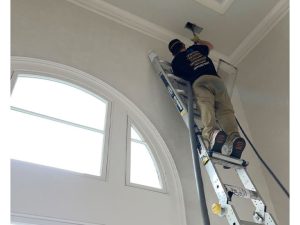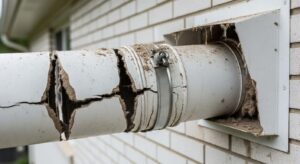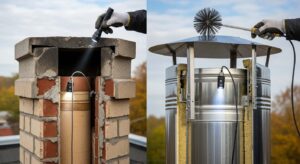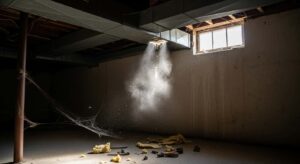If you manage a commercial building, you’ve probably dealt with fluctuating utility bills, complaints about stuffy air, or frequent HVAC maintenance. But have you ever thought the culprit might be hiding in your ductwork? Commercial air duct cleaning is one of the most overlooked aspects of building maintenance, yet it plays a crucial role in air quality, energy efficiency, and even compliance with health standards.
In this blog, we’ll explain why commercial air duct cleaning is essential for air quality and efficiency, and how the process works.
Why Commercial Air Duct Cleaning Matters
Even though ducts are hidden behind walls and ceilings, they have a direct impact on the air circulating throughout your building, how well your HVAC system runs, and the cleanliness of your workspace.

Let’s discuss the key reasons commercial duct cleaning should be part of your regular maintenance plan.
1. Protects Indoor Air Quality
Over time, dust, pollen, mold spores, and even bacteria can accumulate in your duct system—especially in high-traffic commercial buildings. As the HVAC system circulates air through the space, these contaminants are blown throughout your offices, work areas, or retail spaces. For employees and customers alike, this can lead to sneezing, eye irritation, headaches, and more serious respiratory symptoms in those with asthma or allergies.
Clean ducts help ensure that the air circulating through your building is free from harmful particles. Especially in settings like healthcare clinics, schools, and office complexes, where people spend long hours indoors, maintaining air quality is essential. Whether it’s part of regular maintenance or a larger project, renovation air duct cleaning is a smart way to remove built-up dust, debris, and allergens. Routine duct cleaning is a simple but effective step toward promoting a safer, more breathable indoor environment.
2. Enhances HVAC Efficiency
When ducts are clogged with dust and debris, your HVAC system has to work harder to maintain the desired temperature throughout the building. That additional strain increases energy use, shortens equipment lifespan, and drives up utility costs. Dirty ducts also reduce airflow, causing uneven heating or cooling that can lead to uncomfortable working conditions in different parts of the building.
By cleaning the ductwork, you’re removing blockages and allowing air to flow freely. This reduces the system’s workload and helps your HVAC components perform at their best. It not only boosts efficiency but can also make your building feel more comfortable throughout the year, with more consistent temperatures from room to room.
3. Reduces Long-Term Maintenance Costs
Clogged or dirty duct systems can trigger a domino effect of mechanical issues. The buildup inside ducts spreads to other parts of the HVAC system, like blowers and coils, where it can lead to overheating or failure. These issues often go unnoticed until major breakdowns occur—leading to costly repairs or even premature equipment replacement.
Regular commercial air duct cleaning minimizes the risk of this kind of damage. It helps keep all HVAC components cleaner, which extends their lifespan and reduces how often you need to schedule major repairs. This can save businesses thousands of dollars in maintenance over the long term, making duct cleaning a smart investment rather than an expense.
4. Prevents Mold and Moisture-Related Issues
Moisture can build up inside ducts due to poor insulation, humidity, or leaks in the HVAC system. When left unaddressed, this moisture becomes a breeding ground for mold. As spores are released into the air, they pose a significant health hazard—especially for people with weakened immune systems or respiratory conditions.
Professional air duct cleaning services can spot mold growth early and remove it safely. In many cases, technicians will also apply antimicrobial treatments to prevent future outbreaks. For commercial buildings in humid environments or industries with strict hygiene requirements, regular cleaning is crucial to staying mold-free.
5. Keeps the Building Cleaner
Dirty ducts don’t just hide their contents—they spread it. When dust and dirt circulate through the ventilation system, it lands on surfaces throughout the building. You may notice that desks, shelves, equipment, or product displays gather dust quickly, even after frequent cleaning.
Cleaning your air ducts cuts down on this re-circulated dirt, leading to a visibly cleaner environment. This helps reduce the workload for your janitorial staff, supports better hygiene standards, and leaves a stronger impression on anyone who enters your space—whether they’re customers, clients, or employees.
Also Read: What Type of Air Duct Cleaning is Best?
6. Creates a Healthier Work Environment
“Sick building syndrome” is a term used when occupants of a building experience health issues linked to time spent inside—often due to poor indoor air quality. Symptoms can include fatigue, headaches, throat irritation, and even skin problems. These issues don’t just affect well-being—they impact productivity and morale.
Clean ductwork ensures better ventilation, fewer allergens, and reduced exposure to airborne irritants. This leads to fewer sick days, improved concentration, and an overall better experience for your team. For business owners, this means not only a healthier workforce but also a more engaged and productive one.
7. Supports Regulatory Compliance
Certain industries—such as healthcare, education, food processing, or manufacturing—are required to meet air quality and cleanliness standards set by health or safety authorities. These inspections may include a review of HVAC systems and their maintenance history.
Keeping your air ducts clean helps ensure compliance with those regulations. It demonstrates that your business is taking proactive steps to maintain a safe and sanitary environment. In some cases, proof of duct cleaning may even be required for licensing or continued operation.
8. Promotes Better First Impressions
The quality of your indoor air can shape how people feel about your business—whether they realize it or not. A space that smells musty or feels stuffy may signal to visitors that your building isn’t well cared for, which can affect their overall impression of your professionalism.
Clean ducts help maintain a fresh-smelling, well-ventilated interior that feels more comfortable to be in. Whether you’re hosting clients, onboarding new employees, or welcoming the public, maintaining a clean environment speaks volumes about your attention to detail and commitment to quality.
9. Helps With Fire Safety in Certain Settings
In certain commercial settings—especially those involving kitchens, manufacturing, or heavy machinery—grease, lint, or flammable dust can build up in ventilation systems. Without regular cleaning, these materials can become a serious fire hazard.
Duct cleaning in these environments helps reduce the risk of fires caused by overheating, electrical sparks, or grease accumulation. It’s a key part of any comprehensive fire prevention plan and is often required by fire codes or insurance policies for high-risk industries.
10. Supports Sustainability Goals
Sustainability is more than a buzzword—it’s a goal many businesses are actively working toward. An energy-efficient HVAC system contributes to that mission by using less power and reducing the building’s carbon footprint.
When your ducts are clean, your system doesn’t have to work as hard. That means less energy used, fewer emissions, and more points toward green certifications like LEED or ENERGY STAR. It’s a small maintenance task with a big impact on both your bottom line and the environment.
Also Read: 5 Best Air Duct Cleaning Companies in New Jersey
How Commercial Air Duct Cleaning Works
Now that you know why it matters, let’s walk through how commercial air duct cleaning actually happens. It’s more than just vacuuming some vents—it’s a multi-step process that involves inspection, equipment, and specialized techniques to ensure a thorough clean.
1. Initial Inspection and Assessment
Every commercial duct cleaning starts with a comprehensive inspection. Technicians use video cameras or flexible scopes to check for dust buildup, mold, pest activity, or blockages. This step helps identify the scope of the problem and plan the best cleaning approach.
In addition to the visual inspection, professionals assess the size and layout of the HVAC system, access points, and areas of concern. This ensures the job is tailored to your facility’s specific needs and safety requirements, rather than using a one-size-fits-all solution.
2. Creating a Cleaning Plan
Based on the inspection, technicians develop a customized cleaning plan. This outlines the tools and methods they’ll use, such as rotary brushes, compressed air whips, or negative air pressure vacuums. Scheduling is also coordinated to minimize disruption during business hours.
This plan helps the cleaning crew work efficiently and ensures nothing is missed. For larger buildings with multiple zones or units, the team may clean sections in phases. A clear plan also keeps the client informed and confident about the scope of work.
3. Sealing Vents and Setting Up Equipment
To prevent contaminants from spreading during cleaning, vents and registers are sealed off. A powerful vacuum system—either truck-mounted or portable—is attached to the ducts to create negative pressure, drawing out debris without releasing it back into the building.
HEPA filtration is commonly used to trap fine particles and ensure clean air is returned into the environment. This setup creates a safe, contained process that protects both your HVAC system and the occupants of your building.
4. Agitation and Dislodging of Debris
Once the system is sealed and vacuum-ready, technicians use specialized tools to dislodge debris. This includes rotating brushes, air whips, or high-pressure air nozzles that scrub the interior surfaces of the ducts.
This step is critical for removing compacted dirt or sticky buildup that ordinary vacuums can’t handle. It’s especially useful for cleaning around bends, branch lines, and difficult-to-reach areas where debris tends to settle.
5. Mold Remediation and Sanitizing (if needed)
If mold is found during inspection or cleaning, it’s treated with EPA-approved antimicrobial agents. These treatments are applied carefully to kill mold and prevent regrowth, without harming your HVAC components or indoor air quality.
In sensitive environments like hospitals or labs, sanitizing the ducts can be just as important as cleaning them. This step ensures that your ventilation system supports a sterile, healthy environment, free from harmful microbes.
Also Read: Does Air Duct Cleaning Get Rid Of Mold?
6. Cleaning Registers, Grilles, and Coils
Ducts are just one part of the HVAC system. Technicians will also clean air registers, return grilles, and sometimes even the coils and fans within the air handler unit. Dust and debris in these areas can restrict airflow or trap allergens.
Thorough cleaning of these components helps maintain overall system performance and improves indoor comfort. It also helps the air entering the ducts stay clean—so the benefits of duct cleaning last even longer.
7. Post-Cleaning Inspection and Report
After cleaning, a final inspection is performed to confirm all debris has been removed. Technicians may use cameras again to show before-and-after images, helping you visualize the difference.
You’ll often receive a written report summarizing what was done, the condition of the system, and any issues that were discovered. This is useful for your maintenance records and for planning future HVAC upkeep.
8. Final Testing and System Restart
With the cleaning complete, the system is restarted. Technicians test airflow, check for leaks, and ensure that everything is functioning correctly. If any abnormalities are found, they’re addressed immediately. As part of the process, disinfecting air duct surfaces helps eliminate lingering bacteria, mold, or allergens—further improving indoor air quality.
You’ll likely notice improved airflow, fewer odors, and quieter operation right away. It’s a final check to ensure your HVAC is back to peak performance—and that your investment in cleaning is paying off.
9. Frequency and Follow-Up Recommendations
Most commercial systems should be cleaned every 3 to 5 years. However, if your building houses high-traffic areas, manufacturing zones, or has had recent renovations, you may need more frequent service.
Professionals can advise you on the best schedule based on your system’s use and condition. Some companies even offer reminder services or maintenance plans to help you stay on track and avoid future buildup.

Also Read: Why Post-Renovation Air Duct Cleaning Should Be a Priority
Need Help With Commercial Air Duct Cleaning?
Clean air ducts don’t just improve HVAC efficiency—they create a safer, healthier environment for everyone inside. Alpha Clean Air offers certified commercial air duct cleaning designed around your building’s specific needs. Our experienced team uses industry-standard tools to deliver deep, lasting results. We also offer residential air duct cleaning if you need your home’s HVAC system cleaned.
Experience the fresh-air difference your commercial space deserves—contact us today to get started!





